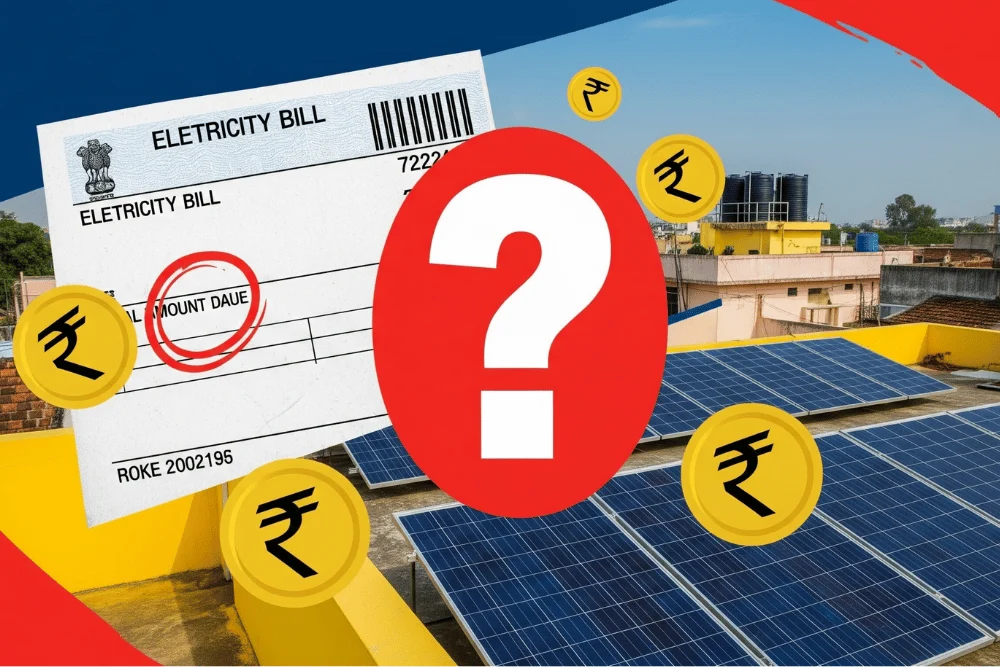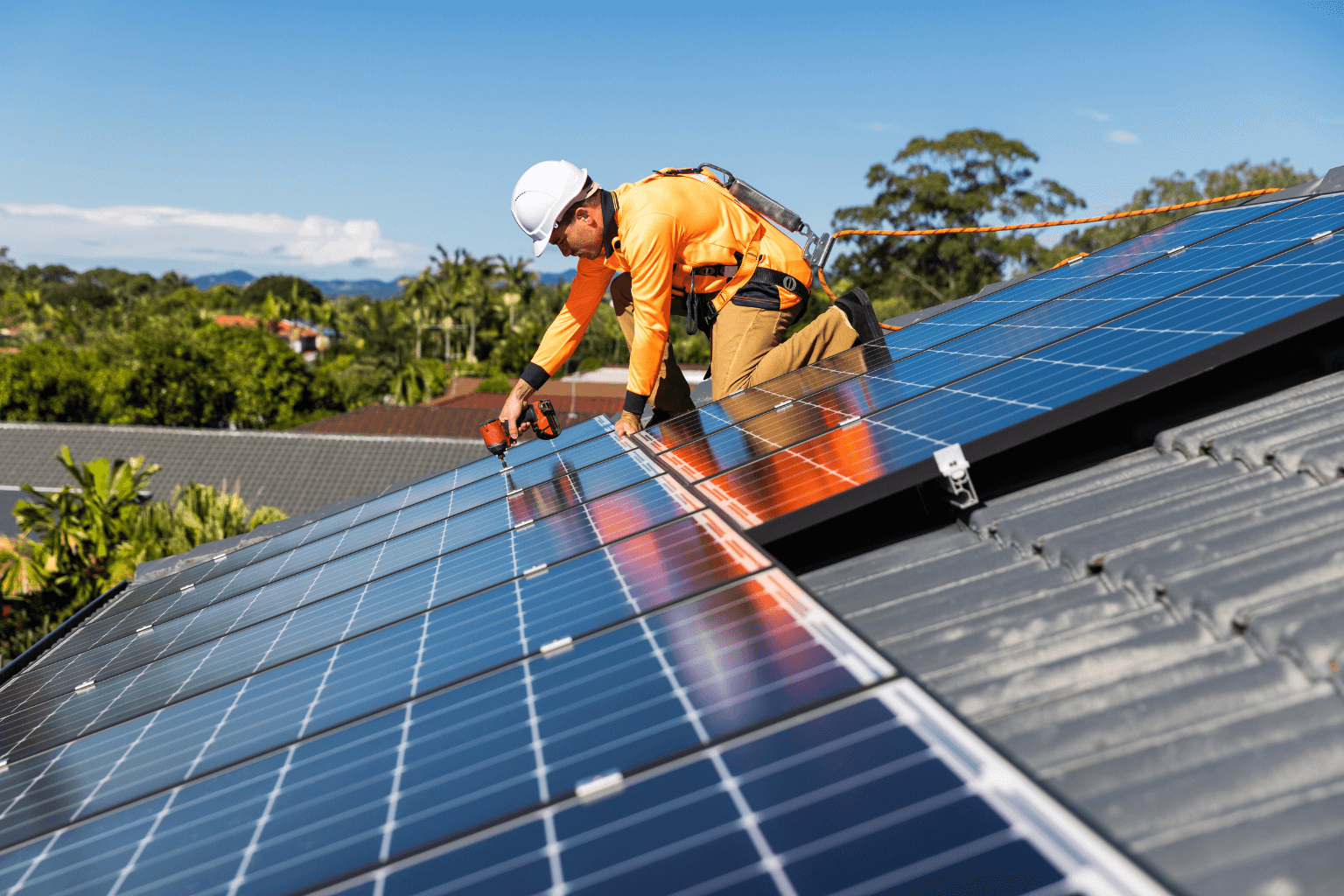Switching to solar is no longer just about being eco-friendly—it’s about smart economics. Rising electricity prices, government subsidies, and better technology have made solar panels a realistic option for Indian households and businesses.
But the first question most people ask is simple: What is the cost of solar panel installation in India, and how does it impact my electricity bill?

The Current Solar Panel Installation Cost in India
As of 2025, the average cost of solar panel installation in India ranges between ₹45,000 to ₹70,000 per kW (kilowatt), depending on the type of system and location.
- 1 kW system → Powers a small household (lights, fans, 1 AC, a fridge). Costs around ₹50,000–₹65,000.
- 3 kW system → Suitable for a medium household. Costs ₹1.5–₹2.0 lakh.
- 5 kW system → Ideal for larger homes with multiple ACs. Costs ₹2.5–₹3.5 lakh.
- 10 kW system → Designed for villas, housing societies, or small businesses. Costs ₹5–₹7 lakh.
These figures usually include solar panels, inverters, wiring, mounting structures, and installation charges.
On-Grid vs Off-Grid Costs
The type of solar system you choose directly affects your budget.
- On-Grid Solar (Grid-Tied):
- Cheaper to install.
- Connected to the electricity grid.
- Extra power generated can be sent back to the grid (net metering).
- Best for reducing electricity bills.
- Cost: ~₹45,000–₹60,000 per kW.
- Off-Grid Solar (With Battery):
- Independent of the grid.
- Comes with batteries to store excess energy.
- More expensive because of battery cost.
- Useful in areas with frequent power cuts.
- Cost: ~₹60,000–₹85,000 per kW.
- Hybrid Solar Systems:
- Mix of on-grid and off-grid.
- Can use grid power, solar power, and stored battery power.
- Offers flexibility but costs more.
Government Subsidies and Incentives
Here’s the good news: the Government of India offers subsidies on solar panel installation for residential projects under the Rooftop Solar Programme.
- For systems up to 3 kW → 40% subsidy.
- For 3–10 kW → 20% subsidy.
- Above 10 kW → No subsidy (usually for commercial projects).
Example: If your 3 kW solar system costs ₹1.8 lakh, you could get around ₹60,000 back as subsidy, bringing your net cost closer to ₹1.2 lakh.
This drastically reduces the payback period and makes solar panels much more affordable.
What It Really Means for Your Electricity Bill
Now let’s talk about the part everyone cares about—savings.
A typical 1 kW solar system generates 4–5 units per day (around 1,500 units annually). Multiply that by your electricity rate, and you’ll see the difference.
- At ₹7 per unit, 1 kW saves ~₹10,500 per year.
- A 3 kW system saves ₹30,000+ annually.
- A 5 kW system can slash ₹50,000+ annually.
Most households can reduce their electricity bills by 70–90%, depending on usage. Some even bring it down to almost zero.
Return on Investment (ROI)
Yes, solar panel installation cost in India feels like a big upfront investment. But when you compare it to long-term savings, the math is compelling.
- Payback period: 4–6 years (with subsidy).
- Lifespan of solar panels: 20–25 years.
- After breakeven, you’re essentially enjoying free electricity for nearly two decades.
That’s why experts call solar panels not an expense, but an asset.
Factors That Affect Solar Installation Cost in India
Several elements can push the cost up or down:
- Type of panels – Monocrystalline panels are more efficient but costlier; polycrystalline panels are cheaper but less efficient.
- Roof type & space – Flat roofs vs slanted roofs affect mounting structure design and installation effort.
- Battery requirement – Adding lithium-ion batteries can almost double your cost.
- Inverter quality – High-efficiency inverters are pricier but improve system performance.
- Location – Labor costs and sunlight availability differ across states.
Solar and the Bigger Picture
Going solar doesn’t just cut bills. It also reduces dependency on fossil fuels and lowers your carbon footprint. With India targeting 500 GW of renewable energy by 2030, households adopting rooftop solar are directly contributing to national energy independence.
Common Misconceptions About Solar Costs
- “It’s too expensive.” → With subsidies and falling panel prices, solar is more affordable than ever.
- “It won’t work on cloudy days.” → Panels generate electricity even in diffused sunlight, though at lower efficiency.
- “Maintenance costs are high.” → Solar panels only require periodic cleaning and minimal upkeep.
Conclusion: Is Solar Worth It?
When you look at the upfront solar panel installation cost in India, it might feel like a big commitment. But when you factor in government subsidies, rising electricity tariffs, and the fact that solar panels last 25 years, the numbers tell a different story.
What it really means for your electricity bill is simple: huge savings, energy independence, and a future-proof investment.
If your monthly bill is burning a hole in your pocket, solar isn’t just an eco-friendly choice—it’s the smartest financial decision you can make today.



